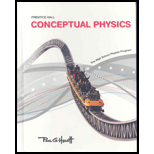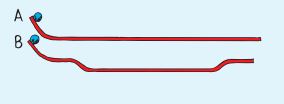
Concept explainers
Refer to the tracks in the previous problem.
a. Does the ball on B roll faster in the dip than the ball rolling along track A?
b. On track B, is the speed gained going down into the dip equal to the speed lost going up the dip? If so, do the balls then have the same speed at the ends of both tracks?
c. Is the average speed of the ball on the lower part of track B greater than the average speed of the ball on A during the same time?
d. So overall, which ball has the greater average speed? (Do you wish to change your answer to the previous exercise?)
(a)
To identify: Whether ball on B roll faster in the dip or the ball on track A.
Answer to Problem 50A
Yes, ball B roll faster in the dip than the ball on track A.
Explanation of Solution
Introduction: Assuming there is no friction on the tracks. When the ball is moving on the downfall curve then speed increases due to gravitational force. When it moves its upward curve then speed decreases as the ball has to do work against gravitational force.
As shown in the figure below:

On track A, only 1 downward curve is present. So, the ball will gain speed and then moves in constant speed on the straight line.
On track B, there are 2 downfalls and one upward curve. So, the ball will gain speed with the first one and then after moving for a while in a straight line will again gain speed on the second downfall.
Conclusion: Thus, Ball on track B will roll faster than the ball on track A.
(b)
Speed of balls at the ends of both tracks.
Answer to Problem 50A
Both balls have the same speed at the end of their respective track.
Explanation of Solution
Introduction: Average speed is calculated as the total distance traveled on the tracks divided by the time taken.
On track A, the ball accelerates on a single dip and then moves with a constant speed.
On track B, there are 2 dips and one up. So, the ball will gain speed with the first one and then after moving for a while in a straight line will again gain speed on the second downfall. Due to the upward curve, it will work against gravity. Thus, its speed will decrease and ends up with a similar speed as the ball has at the end of track A.
B track can be illustrated as shown in the figure below:

P: slower, but accelerating
Q: faster and constant speed
R: Firstly, accelerates and moves with constant speed then decelerates
S: fastest speed equivalent to segment Q
The average speed of the ball will have a faster speed as on segment Q.
Conclusion:
Both balls have the same speed at the end of their respective tracks.
(c)
To check: The average speed of the ball on the lower part of track B is greater or the ball on track A during the same time.
Answer to Problem 50A
Yes, the average speed of the ball on the lower part of track B is greater than the ball on track A during the same time.
Explanation of Solution
Introduction:
Average speed is calculated as the total distance traveled on the tracks divided by the time taken.
As explained above for the sub-section b, it is clear that the ball on track B has 2 dips that accelerate the ball twice and hence, increases its speed.
Conclusion:
Thus, the average speed of the ball on the lower part of track B is greater than the ball on track A during the same time.
(d)
The ball with the greater average speed overall.
To check: Changes need to be made in the previous exercise.
Answer to Problem 50A
Ball on track B has a greater average speed overall. No changes need to be done in the previous exercise.
Explanation of Solution
Introduction: Average speed is calculated as the total distance traveled on the tracks divided by the time taken.
As explained above for the sub-section b, it is clear that the ball will accelerate twice and gain speed as compared to the single dip acceleration gained by the ball on track A.
Since balls gain speed on their track differently but end up with the same speed during the same time on the complete track. But, no ball on track B has greater average speed overall, when compared with the other ball on track A.
Conclusion: Ball on track B has a greater average speed overall. No changes need to be done in the previous exercise.
Chapter 4 Solutions
Conceptual Physics: The High School Physics Program
Additional Science Textbook Solutions
Essential University Physics: Volume 2 (3rd Edition)
Introduction to Electrodynamics
Physics for Scientists and Engineers: A Strategic Approach with Modern Physics (4th Edition)
Conceptual Physical Science (6th Edition)
Physics for Scientists and Engineers: A Strategic Approach, Vol. 1 (Chs 1-21) (4th Edition)
Essential University Physics (3rd Edition)
 College PhysicsPhysicsISBN:9781305952300Author:Raymond A. Serway, Chris VuillePublisher:Cengage Learning
College PhysicsPhysicsISBN:9781305952300Author:Raymond A. Serway, Chris VuillePublisher:Cengage Learning University Physics (14th Edition)PhysicsISBN:9780133969290Author:Hugh D. Young, Roger A. FreedmanPublisher:PEARSON
University Physics (14th Edition)PhysicsISBN:9780133969290Author:Hugh D. Young, Roger A. FreedmanPublisher:PEARSON Introduction To Quantum MechanicsPhysicsISBN:9781107189638Author:Griffiths, David J., Schroeter, Darrell F.Publisher:Cambridge University Press
Introduction To Quantum MechanicsPhysicsISBN:9781107189638Author:Griffiths, David J., Schroeter, Darrell F.Publisher:Cambridge University Press Physics for Scientists and EngineersPhysicsISBN:9781337553278Author:Raymond A. Serway, John W. JewettPublisher:Cengage Learning
Physics for Scientists and EngineersPhysicsISBN:9781337553278Author:Raymond A. Serway, John W. JewettPublisher:Cengage Learning Lecture- Tutorials for Introductory AstronomyPhysicsISBN:9780321820464Author:Edward E. Prather, Tim P. Slater, Jeff P. Adams, Gina BrissendenPublisher:Addison-Wesley
Lecture- Tutorials for Introductory AstronomyPhysicsISBN:9780321820464Author:Edward E. Prather, Tim P. Slater, Jeff P. Adams, Gina BrissendenPublisher:Addison-Wesley College Physics: A Strategic Approach (4th Editio...PhysicsISBN:9780134609034Author:Randall D. Knight (Professor Emeritus), Brian Jones, Stuart FieldPublisher:PEARSON
College Physics: A Strategic Approach (4th Editio...PhysicsISBN:9780134609034Author:Randall D. Knight (Professor Emeritus), Brian Jones, Stuart FieldPublisher:PEARSON





